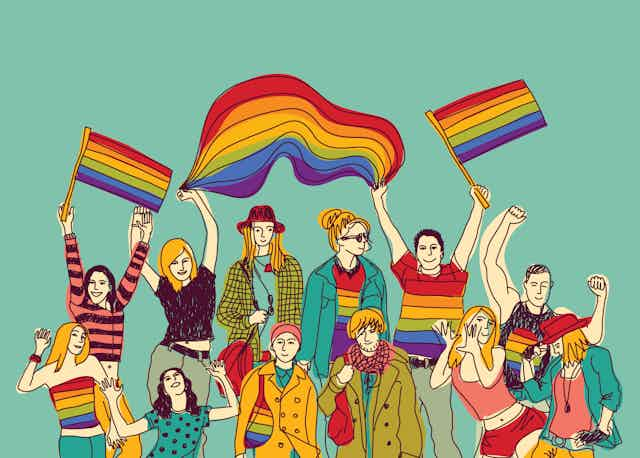If you don’t identify as lesbian, gay, bisexual, trans, asexual, pansexual, queer or questioning, the chances are you almost certainly know someone who does – it might be a friend, a cousin, a niece, an uncle or a colleague. And you might even consider yourself an “ally” to the LGBTQ community – someone who speaks out if they witness discrimination or derogatory remarks.
In the UK, we have made great legal strides towards equality, but culturally we are still playing catch up – and higher education is just one of the places where LGBTQ people are being failed.
To put it bluntly, UK universities are still difficult places for people who aren’t heterosexual or cisgender – where a person’s gender identity matches the sex that they were assigned at birth. And LGBTQ students continue to experience extremely high levels of discrimination. All of which can be significantly damaging.
Research has shown how both interpersonal and institutional discrimination (as well as fears of discrimination) can cause people to stay “in the closet” – because of worries about negative responses to their sexual orientation or gender identity. This causes chronically high levels of stress, known as “minority stress” – which is essentially stress experienced by stigmatised minority groups.
It has been shown that minority stress contributes to higher levels of mental and physical health problems within the LGBTQ community.
Higher than average numbers of LGBTQ students are also estranged from their families – with all the financial and emotional support implications that come with this.
This combination of factors probably goes some way in explaining why LGBTQ students are much more likely to drop out of university than their heterosexual or cisgendered peers.
Unsafe on campus?
Our research also suggests that the university teaching and learning environment is seen as one of the least safe places to be “out” at university, even more so than halls of residence or sports clubs, which have traditional been seen as most problematic.
We found that although staff members are not necessary homo, bi or transphobic in attitude, they do not have the confidence to explore and challenge discriminatory comments or attitudes in the classroom.

This can leave many lecturers feeling they might “get it wrong” – and so they do nothing. The students we spoke to expressed disappointment in this, noting that the failure to call out these kinds of situations amounted to complicity in this type of discrimination.
The right support
There are of course many things that a university can do to support LGBTQ students who are experiencing difficulties at university. This can include counselling services that are LGBTQ friendly, chaplaincy services where chaplains are able to work with LGBTQ students of faith, as well as careers services that acknowledge the concerns students may have about being “out” at work and welfare tutors specifically trained to support these students.
But while this support is all well and good, for real change to happen, there needs to be increased “visibility” rather than “erasure” of LGBTQ identities in the higher education environment. This includes visibility within the curriculum, as well as outside of it.
This is important, because erasure isn’t always malicious in intent. It could be something as seemingly simple as only using binary gender categories, or assuming that a student has or wants a partner – along with what gender that partner might be.
Full inclusion
Creating a more inclusive environment on campus and in higher education can come from many different places – both from staff who identify as LGBTQ and are prepared to be “out” in the lecture halls or laboratories. Along with those cisgender or straight “allies” who might “call out” a derogatory or dismissive comment from a colleague or student.
Inclusivity can also come from the student population, where strong student societies or LGBTQ officers can be a powerful influence on the culture of an organisation.
This is why, as part of our research, we have developed a specific model to help make teaching and learning environments more inclusive at universities. The model covers three domains – “inclusive language”, “positive role models” and “diverse curriculum content”.

Of course, inclusivity will look different in different disciplines. For instance computer science may be able to do “role models” effectively – thanks in part to Alan Turing – but history may be better placed to work on inclusive “curriculum content”. This could be done by challenging the social construction of texts or artworks. Vocational subjects on the other hand – such as medicine, nursing or social work – could use the model to prioritise their students’ understanding of “inclusive language” as this will help them to build trust and rapport with future clients or patients.
As part of the project, we are also working with other universities in the sector to create a development programme for higher and further education institutions who are keen to explore and critique their cultures. The programme will allow institutions to identify and share ways to create a more inclusive and diverse learning environment for students. And it will, of course, also help to ensure opportunities to make LGBTQ identities and voices more visible in higher education are not missed.

